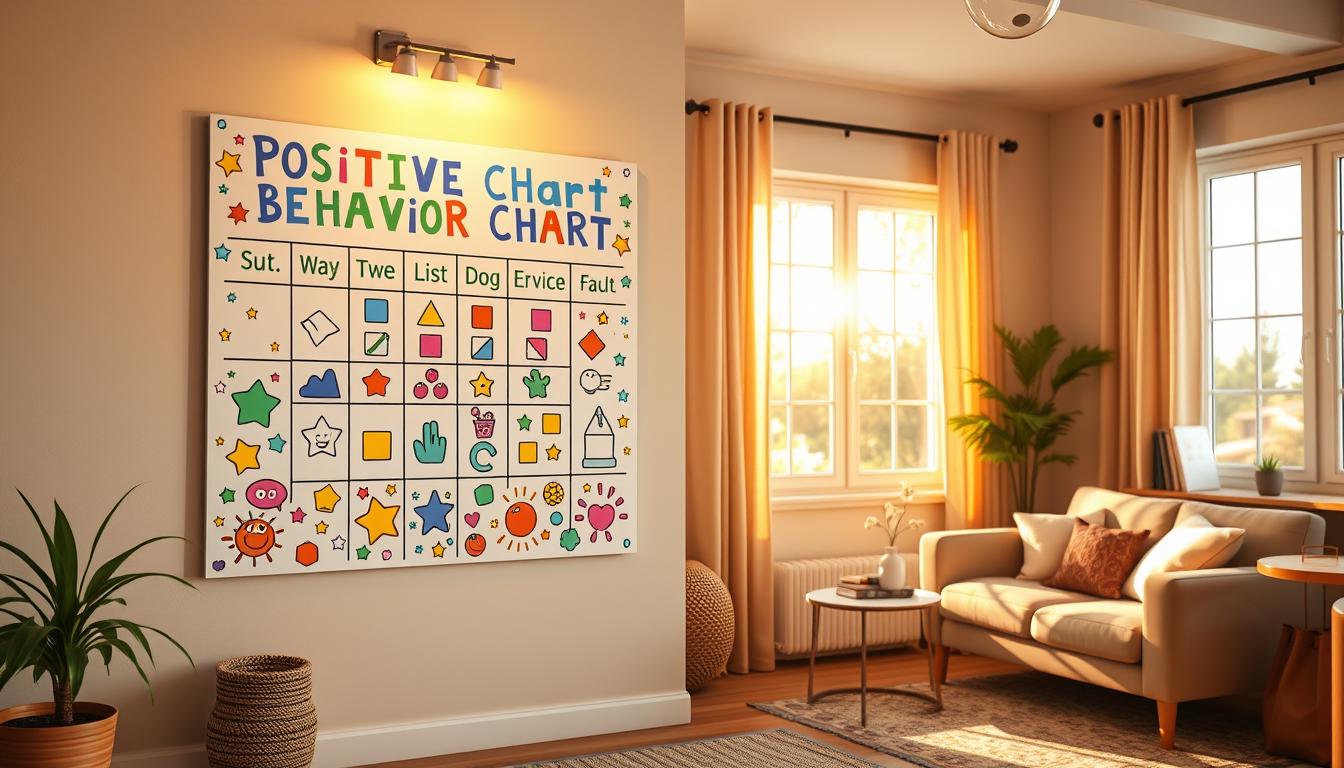Positive Behavior Charts: Motivate Kids to Succeed
When Sarah introduced a colorful tracking system to help her 5-year-old finish breakfast on time, magic happened. What used to be morning meltdowns turned into eager races to place star stickers on their kitchen display. This simple strategy not only solved their daily struggle but became a cherished ritual celebrating small victories.
Visual reward systems create clear connections between actions and recognition. For kids aged 3-8, seeing progress through stickers or checkmarks makes abstract concepts like responsibility feel tangible. These tools turn everyday tasks into achievable challenges, helping young learners build confidence through visible accomplishments.
Parents report success with various applications – from mastering shoe-tying to remembering polite words. The secret lies in immediate feedback that celebrates effort rather than punishing mistakes. Customizable formats let families focus on specific goals while maintaining an upbeat, game-like atmosphere.
Key Takeaways
- Visual tracking systems make habit-building engaging for young children
- Effective for ages 3-8 through immediate, tangible feedback
- Focuses on celebrating successes rather than punishing mistakes
- Customizable for different skills from manners to self-care routines
- Helps replace challenging actions with constructive alternatives
Introduction to Positive Behavior Charts
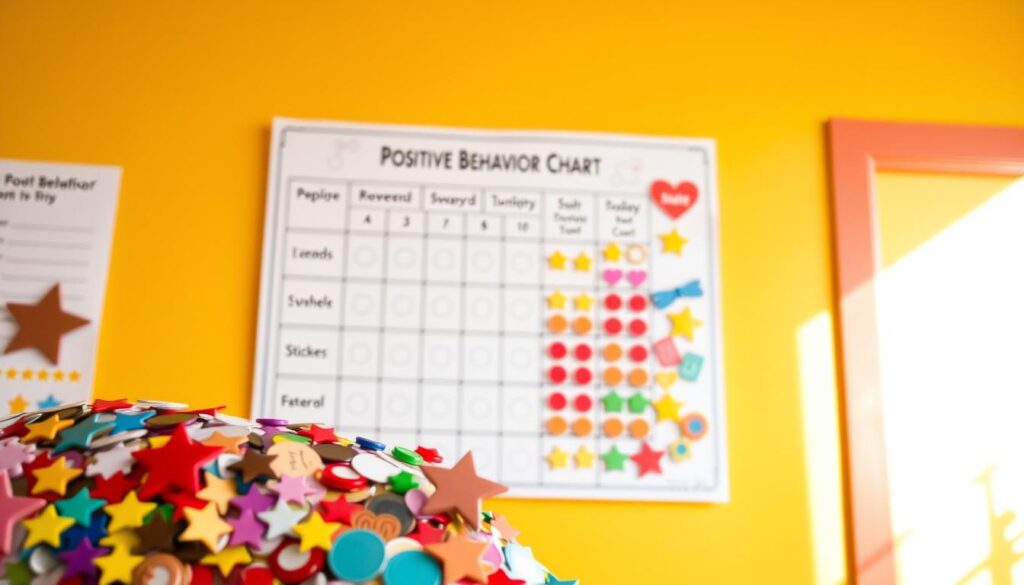
Imagine a tool that turns daily chores into exciting quests—where completing tasks earns colorful badges and cheers. These visual systems help families celebrate growth while teaching essential skills. Unlike traditional methods, they focus on what kids do right rather than what needs fixing.
How Tracking Systems Work
Simple trackers use stickers or stars to mark progress toward goals like cleaning up toys or using kind words. Each mark represents a specific achievement, creating clear milestones. For example:
- Brushing teeth twice daily = 2 smiley faces
- Putting shoes away = 1 gold star
Kids see their efforts adding up, which builds excitement. One parent shared: “Our chart turned ‘I can’t’ into ‘Watch me!'”
Why Recognition Matters
Studies show immediate praise strengthens neural pathways linked to good habits. When a child earns rewards, their brain releases dopamine—a chemical that makes them want to repeat the action. This approach works 75% better than scolding, according to Child Development Institute research.
Teachers and caregivers find these systems effective because they:
- Offer concrete proof of progress
- Make expectations visual and understandable
- Turn abstract concepts like responsibility into hands-on lessons
Understanding the Benefits of Behavior Charts
Jamie’s mom nearly cried when her 6-year-old cleared his plate without being asked. Their simple tracker transformed daily struggles into moments of pride. Visual systems like these offer more than sticker collections—they reshape how families celebrate growth.
Encouraging Positive Behaviors
These tools flip the script on daily interactions. Instead of nagging about forgotten chores, families spotlight achievements like sharing toys or finishing homework. One study found kids receive 9x more corrective comments than praise—charts help balance this ratio.
Parents notice small wins they might otherwise miss. A high-five for remembering to say “please” or a star for brushing hair builds momentum. “It’s like treasure hunting for good choices,” explains a preschool teacher from Ohio.
Enhancing Motivation and Self-Esteem
Kids thrive when they see their efforts matter. Colorful markers climbing a chart give physical proof of their capabilities. This visible progress teaches self-monitoring—a skill that boosts classroom performance later.
| Traditional Approach | Chart System |
|---|---|
| Focuses on mistakes | Highlights successes |
| Generic praise | Specific feedback |
| External rewards | Builds internal pride |
Over time, the need for stickers fades. Children start feeling proud of their actions naturally. A 2023 UCLA study showed kids using these systems demonstrated 40% more persistence in tough tasks than peers.
Families report happier interactions as charts create built-in celebration points. Instead of constant reminders, parents become cheerleaders. Kids learn their choices directly impact outcomes—a lesson that sticks long after the chart comes down.
How to Implement Positive Behavior Charts at Home
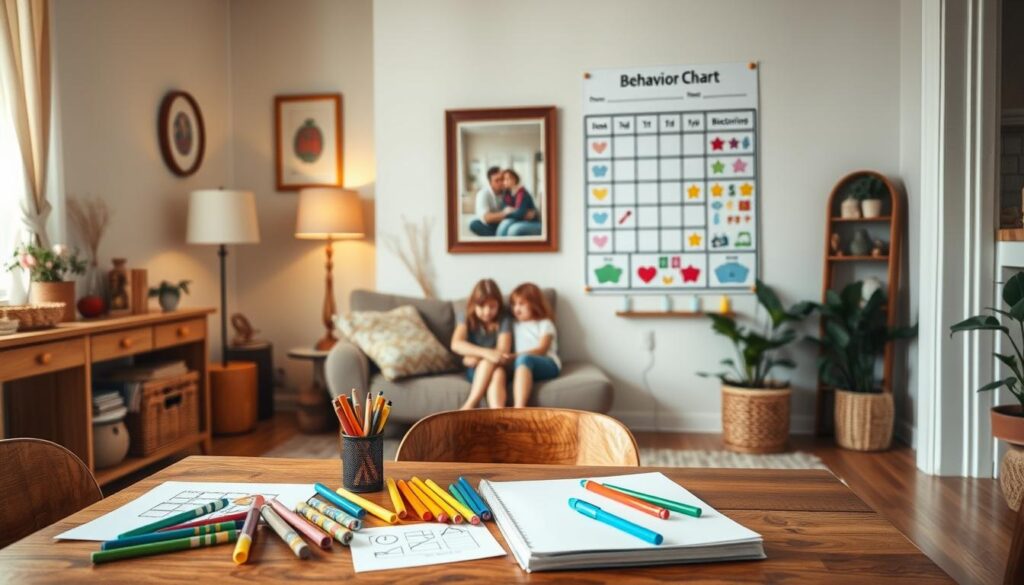
Ever watched a kid light up when earning their first gold star? That spark of pride fuels lasting change when channeled through well-designed tracking systems. Let’s break down the roadmap for creating effective visual tools that turn daily routines into growth opportunities.
Identifying Target Behaviors
Start by picking one clear action your child can master. The CDC recommends specific phrases like “hang backpack after school” instead of vague terms. A kindergarten teacher shares: “Kids succeed fastest when they know exactly what ‘winning’ looks like.”
Focus on achievable goals matching their age. A 4-year-old might track “putting toys in bin,” while an 8-year-old could handle “completing homework before dinner.”
Selecting the Right Type of Chart
Match the format to your child’s interests and abilities. Younger kids often thrive with simple sticker charts, while older ones enjoy point systems leading to bigger rewards. Consider:
- Magnetic boards for tactile learners
- Digital apps for tech-savvy families
- Puzzle-piece charts where each earned piece reveals a picture
Setting Up a Reward System
Choose incentives that spark genuine excitement. Immediate rewards work best—think extra playtime or choosing dinner music. One parent reported: “Five earned stickers = Saturday park trip became our magic formula.”
Phase out tangible rewards gradually as habits form. The real win comes when kids internalize pride in their actions. Remember to celebrate progress loudly—your enthusiasm fuels theirs!
Tips for Making Reward Charts Work Effectively

The real magic happens when families pair colorful trackers with smart strategies. Timing and communication turn simple charts into powerful teaching tools that build lasting habits.
Choosing Clear and Positive Descriptions for Behaviors
Label actions using specific language kids understand. Instead of “Be good,” try “Put toys away before dinner.” A preschool teacher shares: “When we say ‘Use gentle hands,’ children know exactly how to succeed.”
Focus on what to do rather than what to stop. “Walk in the hallway” works better than “Don’t run.” This approach gives clear direction while keeping the tone upbeat.
Ensuring Consistency with Immediate Praise
Hand out stickers the moment you spot the desired action. Waiting until bedtime weakens the connection. One parent noted: “When my son shares, I say ‘Great teamwork!’ and add a star right then.”
If a child misses a goal, focus on future chances. Say “Let’s try again after lunch” instead of removing earned rewards. Studies show this keeps motivation high while teaching resilience.
Keep celebrations genuine but brief. A quick high-five or happy dance maintains momentum without disrupting routines. Over time, kids start feeling proud of their choices naturally – the ultimate reward!
Customizing Behavior Charts for Different Ages and Needs
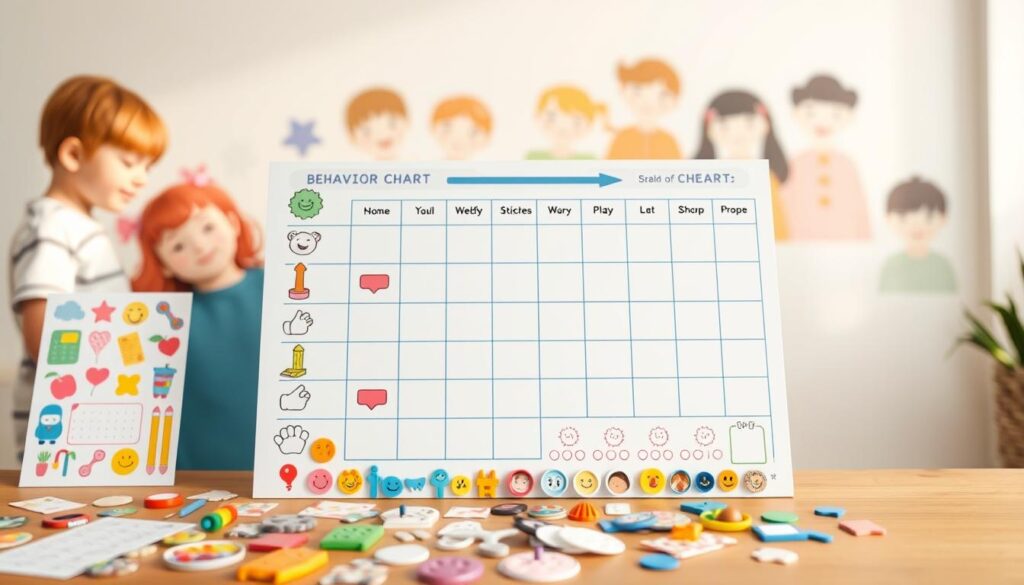
Every child’s journey to success looks different—and so should their progress trackers. Tailoring these tools to match developmental stages keeps motivation high while respecting changing needs. Let’s explore how to adapt visual systems as kids mature.
Design Choices That Spark Joy
Preschoolers light up when their tracker features favorite cartoon characters or bright colors. Simple layouts with 5-10 spaces work best for short attention spans. A kindergarten teacher shares: “Three-year-olds adore placing giant stickers they can feel proud of.”
Scaling Complexity With Maturity
School-age children often prefer detailed systems matching their growing abilities. Consider these age-based adjustments:
| Ages 3-5 | Ages 6-8 |
|---|---|
| 10-step max | 15-20 steps |
| Family kitchen display | Bedroom privacy |
| Daily rewards | Weekly goals |
Digital apps become valuable tools for older kids. They allow discreet tracking during school days while maintaining consistency. One parent reported: “Our tween loves unlocking achievement badges on her tablet.”
Remember to update themes as interests evolve. What excites a 4-year-old dinosaur fan might bore an 8-year-old aspiring scientist. Regular check-ins ensure the system grows alongside your child’s developing skills and passions.
Troubleshooting and Adapting When Challenges Arise
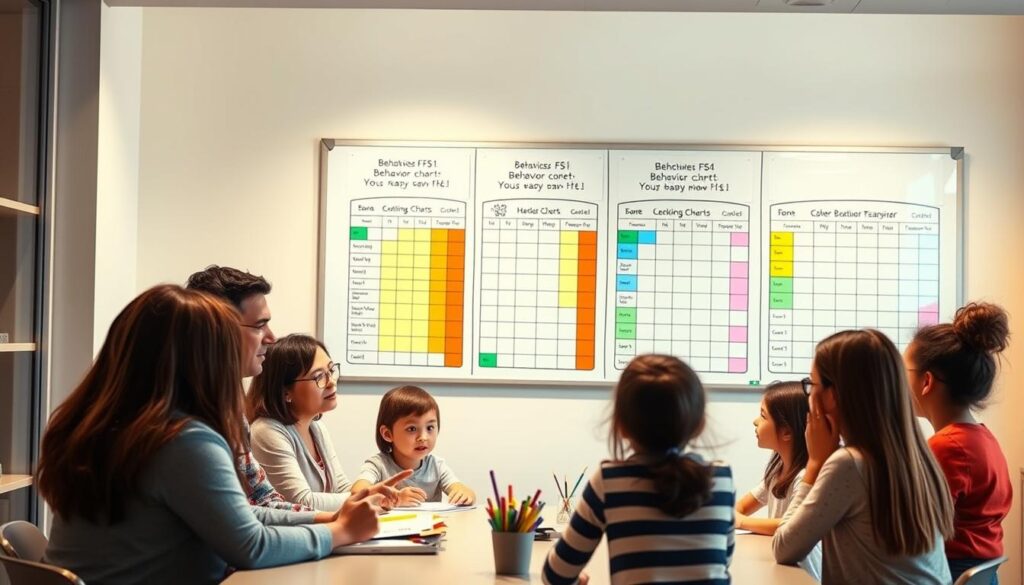
Sometimes stickers lose their sparkle, and that’s okay. Even the best systems need tweaks when life throws curveballs. Whether managing sibling dynamics or reviving stalled progress, flexibility keeps motivation alive.
Harmonizing Multiple Trackers
When tracking progress for siblings, personalization prevents rivalry. Give each child their own chart with unique goals matching their abilities. A 7-year-old might earn stars for homework time while their preschool sibling focuses on sharing toys.
- Use different colored markers for each individual chart
- Celebrate milestones separately – “Your reading time rocks!” vs. “Great sharing!”
- Rotate reward choices weekly based on changing interests
Reviving Stalled Systems
If rewards stop working, try these fixes:
- Shorten wait times – swap weekly goals for daily wins
- Mix tangible rewards (extra screen time) with experiences (picnic lunch)
- Simplify complex charts – use 3-step visuals instead of 10
A teacher shared: “When Carlos stopped caring about stickers, we switched to tracking ‘helping hands’ with handprint drawings. Suddenly, he was all in!”
Check if your child understands expectations. Clear phrases like “hang coats by 4 PM” work better than vague “be responsible” goals. If confusion persists, start fresh with one specific action and rebuild momentum.
Conclusion
Reward systems aren’t forever tools, and that’s exactly what makes them powerful. When your child consistently shows new skills, stretch the time between earning stars or points. This gradual shift helps turn chart successes into lasting habits.
Once goals feel automatic, celebrate retiring the tracker together. One parent shared: “We framed our completed chart as proof of what Jamie could do!” Take a week off before tackling new challenges to let confidence solidify.
These visual systems particularly help autistic children or those with disabilities by making expectations clear. A colorful grid showing “shoes on by 8 AM” works better than abstract instructions for many young learners.
Remember – the real win comes when stickers become unnecessary. Kids start feeling proud of putting toys away or finishing chores without reminders. That internal motivation becomes their personal superpower for tackling future tasks!
FAQ
What are behavior charts?
How do reward systems support child development?
What makes these tools effective for boosting self-esteem?
How do I start using a chart at home?
What if my child loses interest in the chart?
How do I handle sibling dynamics with charts?
Can charts work for teens?
What rewards are best for younger children?

Adam Peter is a finance, travel, and automotive writer with over a decade of experience. He creates clear, practical content to help readers manage their money, explore the world with confidence, and make informed decisions about cars and travel gear. His work blends expert insight with real-world usefulness.

